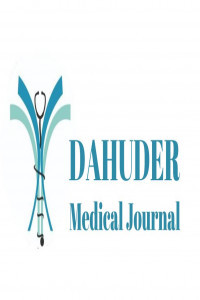Follow-up and treatment of patients with Common Variable Immune Deficiency: A single-center experience
Follow-up and treatment of patients with Common Variable Immune Deficiency: A single-center experience
Objectives: Common Variable Immunodeficiency (CVID) is a primary immunodeficiency characterized by immunoglobulin production defect. Our study aimed to create awareness of primary immunodeficiency in adult patients, establish standard approaches for clinical follow-up of CVID patients, and reveal the clinical characteristics of CVID patients in our region.
Method: The study was conducted in patients with diagnosed and newly diagnosed CVID. The demographic and clinical characteristics of the patients and their treatment data were analyzed retrospectively and prospectively.
Results: Thirteen of our patients were female and 12 were male. The mean age at diagnosis of the patients was 30.32 (2-57) and the mean delay in diagnosis was 9.32 months (0-30). The most common clinical finding of our patients at the time of admission was an infection. Among the infections identified, 3 patients had URTI, 19 had LRTI, and 2 had gastroenteritis. In 16 of our patients, bronchiectasis was detected at the time of diagnosis, and in 1 during the follow-up period. In the examinations performed in terms of organomegaly, splenomegaly was found in 11 patients and hepatomegaly was found in 8 patients. When patients were screened for autoimmune disease, ITP and celiac were found in 2 patients at the beginning, while autoimmune thyroiditis was developed in 1 patient and SLE in 1 patient during follow-up. Our patients were given IVIG treatment at regular intervals. The number of reactions seen in a total of 421 IVIG infusions was two.
Conclusion: Primary immunodeficiencies should definitely be considered in patients with recurrent infections and resistance to antibiotic therapy. Patients should be followed according to established follow-up and treatment protocols in order to reduce and diagnose complications.
___
- Schroeder, HW, Jr. “Genetics of IgA deficiency and common variable immunodeficiency.” Clin Rev Allergy Immunol 2000;19(2): 127-140.
- Notarangelo, LD, A Fischer, RS Geha, JL Casanova, H Chapel, ME Conley, et al. “Primary immunodeficiencies: 2009 update.” J Allergy Clin Immunol 2009;124(6): 1161-1178.
- Conley, ME, J Rohrer, L Rapalus, EC Boylin and Y Minegishi. “Defects in early Bcell development: comparing the consequences of abnormalities in pre-BCR signaling in the human and the mouse.” Immunol Rev 2000;178: 75-90.
- Hammarstrom, L, I Vorechovsky and D Webster. “Selective IgA deficiency (SIgAD) and common variable immunodeficiency (CVID).” Clin Exp Immunol 2000;120(2): 225-231.
- Chapel, H, M Lucas, M Lee, J Bjorkander, D Webster, B Grimbacher, et al. “Common variable immunodeficiency disorders: division into distinct clinical phenotypes.” Blood 2008;112(2): 277-286.
- Quinti, I, A Soresina, G Spadaro, S Martino, S Donnanno, C Agostini, et al. “Longterm follow-up and outcome of a large cohort of patients with common variable immunodeficiency.” J Clin Immunol 2007;27(3): 308-316.
- Ardeniz, O, CB Avci, A Sin, G Ozgen, F Gunsar, N Mete, et al. “Vitamin D deficiency in the absence of enteropathy in three cases with common variable immunodeficiency.” Int Arch Allergy Immunol 2008;147(1): 74-83.
- Urschel, S, L Kayikci and U Wintergerst. “Common variable immundeficiency disorders in children: delayed diagnosis despite typical clinical presentation.” J Pediatr 2009;(154): 888.
- Conley, ME, LD Notarangelo and A Etzioni. “Diagnostic criteria for primary immunodeficiencies. Representing PAGID (Pan-American Group for Immunodeficiency) and ESID (European Society for Immunodeficiencies).” Clin Immunol 1999;93(3): 190-197.
- Cunningham-Rundles, C and C Bodian. “Common variable immunodeficiency: clinical and immunological features of 248 patients.” Clin Immunol 1999;92(1): 34-48.
- Bates, CA, MC Ellison, DA Lynch, CD Cool, KK Brown and JM Routes. “Granulomatous-lymphocytic lung disease shortens survival in common variable immunodeficiency.” J Allergy Clin Immunol 2004;114(2): 415-421.
- Wood, P, S Stanworth, J Burton, A Jones, DG Peckham, T Green, et al. “Recognition, clinical diagnosis and management of patients with primary antibody deficiencies: a systematic review.” Clin Exp Immunol 2007;149(3): 410-423.
- Daniels, JA, HM Lederman, A Maitra and EA Montgomery. “Gastrointestinal tract pathology in patients with common variable immunodeficiency (CVID): a clinicopathologic study and review.” Am J Surg Pathol 2007;31(12): 1800-1812.
- Agarwal, S and L Mayer. “Gastrointestinal manifestations in primary immune disorders.” Inflamm Bowel Dis 2010;16(4): 703-711.
- Resnick, ES, EL Moshier, JH Godbold and C Cunningham-Rundles. “Morbidity and mortality in common variable immune deficiency over 4 decades.” Blood 2012;119(7): 1650-1657.
- Notarangelo, LD, A Fischer, RS Geha, JL Casanova, H Chapel, ME Conley, et al. (2009). “Primary immunodeficiencies: 2009 update.” J Allergy Clin Immunol 124(6): 1161-1178.
- Agarwal, S and C Cunningham-Rundles. “Autoimmunity in common variable immunodeficiency.” Curr Allergy Asthma Rep 2009; 9(5): 347-352.
- Busse, PJ, S Razvi and C Cunningham-Rundles. “Efficacy of intravenous immunoglobulin in the prevention of pneumonia in patients with common variable immunodeficiency.” J Allergy Clin Immunol 2002;109(6): 1001-1004.
- Chapel, HM, GP Spickett, D Ericson, W Engl, MM Eibl and J Bjorkander. “The comparison of the efficacy and safety of intravenous versus subcutaneous immunoglobulin replacement therapy.” J Clin Immunol 2000;20(2): 94-100
- Yayın Aralığı: Yılda 4 Sayı
- Başlangıç: 2021
- Yayıncı: DAHUDER
Sayıdaki Diğer Makaleler
Approach To Diagnosis And Treatment Of Familial Hyperlipidemia
Kübra ÇERÇİ, İmge Bortay TEKİN, Seyit UYAR
İhsan SOLMAZ, Ömer Faruk ALAKUŞ, Yusuf YAKUT, Yunus TEKİN, Sedrettin KOYUN, Eşref ARAÇ
Right time for the community based mental health care
Evaluation of Interleukin 6 Levels in Severe COVID-19 Patients
Yıldız OKUTURLAR, İftihar KÖKSAL, Yasemin GÜNDOĞDU, Arzu YÜKSEL, Özgür OKUTURLAR, Fadıl HAVAS, Cem GUN
